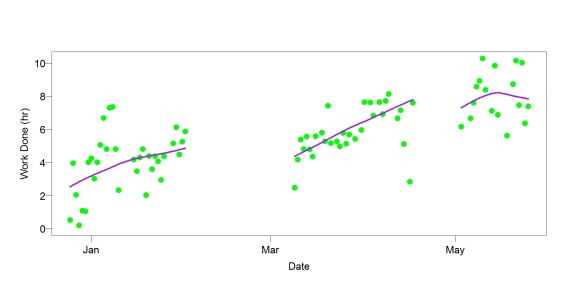
This graph shows how much work I did in early 2013 (one point = one day). It gradually rose from about 2 hours/day to about 8 hours/day. I did not literally get to 8 hours/day because some tasks got counted extra. For example, one minute of Chinese counted as 2 minutes and one minute of book writing counted as 1.5 minutes. The data is in three blocks because sometimes I didn’t use the tracking program (e.g., due to travel).
I gathered the data with a program that gave percentile feedback. Percentile feedback compares where you are now (measured in various ways, such as time of day, e.g., 3 pm) to where you were at the same time on previous days and summarizes the comparison with a percentile: 75 means more work done than on 75% of previous days at the same time; 50 means more work done than on 50% of previous days at the same time. Displays of such feedback, I noted earlier,
are curiously likable. They usually praised me, in the sense that the percentile score was usually well above 50. . . . They are calm, in the sense that they do not change quickly. . . . Every improvement was noticed and rewarded — and every non-improvement was also gently noted. It was as if the display cared.
Nick Winter used with an earlier version of percentile feedback (video). “The percentile feedback has been a huge success,” he wrote. “I’m getting way more done than I ever did, and I’m much better at prioritizing toward my main project.”
The new version has several improvements. The biggest change is weights — different tasks may have different weights. Tasks that are more valuable or more difficult get more weight. If you keep failing to do something important, you increase its weight, making it more attractive. For a long time, I have had trouble making myself study Chinese. This has helped a lot.
It has also pushed me away from blogging (less valuable) toward book writing (more valuable). I am writing a book about personal science. The chapter I am writing now is about procrastination.
This program has been a big help with procrastination and has improved my use of time in other ways. To get material for the procrastination chapter, I am making the program (written in R) available, along with a draft of the procrastination chapter. I want to find out what happens when other people use it.
To get the program and use it, you need to install R (which runs under Windows, MacOS, and many UNIX platforms), use Dropbox, and use PayPal. You can do some work away from the computer but it won’t work unless you do most of your work at or near the computer.
For better or worse I have learned it is a waste of time to give software to others for free. If you are interested in using it, please send me an email with the following information:
1. Your job.
2. Why you want to try this.
3. How much you will pay (non-refundable after 2 days).
4. How long you will commit to using it.
5. How much you will pay if you don’t meet the commitment (= a refundable amount).
I’ll pick the highest bidders. If you’re one of them, you’ll give me the amount in #3 plus the amount in #5 via PayPal. I’ll install the program on your computer via Dropbox and show you how to use it (in addition to the written instructions). If you use it for the promised length of time, I’ll refund the amount in #5.
